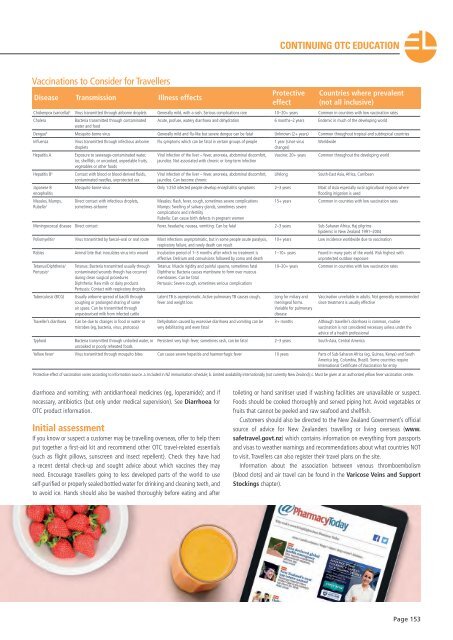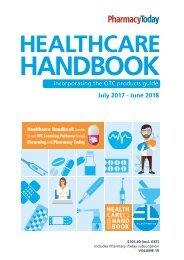2017 HCHB_digital
Create successful ePaper yourself
Turn your PDF publications into a flip-book with our unique Google optimized e-Paper software.
CONTINUING OTC EDUCATION<br />
Vaccinations to Consider for Travellers<br />
Disease Transmission Illness effects<br />
Protective<br />
effect<br />
Countries where prevalent<br />
(not all inclusive)<br />
Chickenpox (varicella) a Virus transmitted through airborne droplets Generally mild, with a rash. Serious complications rare 10–20+ years Common in countries with low vaccination rates<br />
Cholera<br />
Bacteria transmitted through contaminated Acute, profuse, watery diarrhoea and dehydration 6 months–2 years Endemic in much of the developing world<br />
water and food<br />
Dengue b Mosquito-borne virus Generally mild and flu-like but severe dengue can be fatal Unknown (2+ years) Common throughout tropical and subtropical countries<br />
Influenza<br />
Virus transmitted through infectious airborne<br />
droplets<br />
Flu symptoms which can be fatal in certain groups of people 1 year (since virus<br />
changes)<br />
Worldwide<br />
Hepatitis A<br />
Hepatitis B a<br />
Japanese B<br />
encephalitis<br />
Measles, Mumps,<br />
Rubella a<br />
Exposure to sewerage-contaminated water,<br />
ice, shellfish, or uncooked, unpeelable fruits,<br />
vegetables or other foods<br />
Contact with blood or blood-derived fluids,<br />
contaminated needles, unprotected sex<br />
Viral infection of the liver – fever, anorexia, abdominal discomfort,<br />
jaundice. Not associated with chronic or long-term infection<br />
Viral infection of the liver – fever, anorexia, abdominal discomfort,<br />
jaundice. Can become chronic<br />
Vaccine: 20+ years<br />
Lifelong<br />
Common throughout the developing world<br />
South-East Asia, Africa, Carribean<br />
Mosquito-borne virus Only 1:250 infected people develop encephalitis symptoms 2–3 years Most of Asia especially rural agricultural regions where<br />
flooding irrigation is used<br />
Direct contact with infectious droplets,<br />
sometimes airborne<br />
Measles: Rash, fever, cough, sometimes severe complications<br />
Mumps: Swelling of salivary glands, sometimes severe<br />
complications and infertility<br />
Rubella: Can cause birth defects in pregnant women<br />
15+ years Common in countries with low vaccination rates<br />
Meningococcal disease Direct contact Fever, headache, nausea, vomiting. Can be fatal 2–3 years Sub-Saharan Africa, Haj pilgrims<br />
Epidemic in New Zealand 1991–2004<br />
Poliomyelitis a Virus transmitted by faecal–oral or oral route Most infections asymptomatic, but in some people acute paralysis,<br />
respiratory failure, and rarely death can result<br />
10+ years Low incidence worldwide due to vaccination<br />
Rabies Animal bite that inoculates virus into wound Incubation period of 1–3 months after which no treatment is<br />
effective. Delirium and convulsions followed by coma and death<br />
Tetanus/Diphtheria/<br />
Pertussis a<br />
Tuberculosis (BCG)<br />
Traveller’s diarrhoea<br />
Tetanus: Bacteria transmitted usually through<br />
contaminated wounds though has occurred<br />
during clean surgical procedures<br />
Diphtheria: Raw milk or dairy products<br />
Pertussis: Contact with respiratory droplets<br />
Usually airborne spread of bacilli through<br />
coughing or prolonged sharing of same<br />
air space. Can be transmitted through<br />
unpasteurised milk from infected cattle<br />
Can be due to changes in food or water or<br />
microbes (eg, bacteria, virus, protozoa)<br />
Tetanus: Muscle rigidity and painful spasms, sometimes fatal<br />
Diphtheria: Bacteria causes membrane to form over mucous<br />
membranes. Can be fatal<br />
Pertussis: Severe cough, sometimes serious complications<br />
Latent TB is asymptomatic. Active pulmonary TB causes cough,<br />
fever and weight loss<br />
Dehydration caused by excessive diarrhoea and vomiting can be<br />
very debilitating and even fatal<br />
1–10+ years Found in many parts of the world. Risk highest with<br />
unprotected outdoor exposure<br />
10–20+ years Common in countries with low vaccination rates<br />
Long for miliary and<br />
meningeal forms.<br />
Variable for pulmonary<br />
disease<br />
Vaccination unreliable in adults. Not generally recommended<br />
since treatment is usually effective<br />
3+ months Although traveller’s diarrhoea is common, routine<br />
vaccination is not considered necessary unless under the<br />
advice of a health professional<br />
Typhoid<br />
Bacteria transmitted through unboiled water, or Persistent very high fever, sometimes rash, can be fatal 2–3 years South-Asia, Central America<br />
uncooked or poorly reheated foods<br />
Yellow fever c Virus transmitted through mosquito bites Can cause severe hepatitis and haemorrhagic fever 10 years Parts of Sub-Saharan Africa (eg, Guinea, Kenya) and South<br />
America (eg, Columbia, Brazil). Some countries require<br />
International Certificate of Vaccination for entry<br />
Protective effect of vaccination varies according to information source. a. Included in NZ immunisation schedule; b. Limited availability internationally (not currently New Zealand); c. Must be given at an authorised yellow fever vaccination centre.<br />
diarrhoea and vomiting; with antidiarrhoeal medicines (eg, loperamide); and if<br />
necessary, antibiotics (but only under medical supervision). See Diarrhoea for<br />
OTC product information.<br />
Initial assessment<br />
If you know or suspect a customer may be travelling overseas, offer to help them<br />
put together a first-aid kit and recommend other OTC travel-related essentials<br />
(such as flight pillows, sunscreen and insect repellent). Check they have had<br />
a recent dental check-up and sought advice about which vaccines they may<br />
need. Encourage travellers going to less developed parts of the world to use<br />
self-purified or properly sealed bottled water for drinking and cleaning teeth, and<br />
to avoid ice. Hands should also be washed thoroughly before eating and after<br />
toileting or hand sanitiser used if washing facilities are unavailable or suspect.<br />
Foods should be cooked thoroughly and served piping hot. Avoid vegetables or<br />
fruits that cannot be peeled and raw seafood and shellfish.<br />
Customers should also be directed to the New Zealand Government’s official<br />
source of advice for New Zealanders travelling or living overseas (www.<br />
safetravel.govt.nz) which contains information on everything from passports<br />
and visas to weather warnings and recommendations about what countries NOT<br />
to visit. Travellers can also register their travel plans on the site.<br />
Information about the association between venous thromboembolism<br />
(blood clots) and air travel can be found in the Varicose Veins and Support<br />
Stockings chapter).<br />
Page 153



